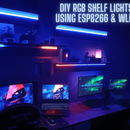Introduction: Play Station Remote Controlled Wireless 3D Printed Car
Who does not love gaming? Racing and Fighting in the Virtual World of Play Station and Xbox!!
So, to bring that fun to the real life I made this Instructable in which I am going to show you how you can use any Play Station Remote Controller (Wired/Wireless) to wirelessly control your electronics/robotics projects with easy to use components.
So get your old Play Station Remotes and begin the build!!
Step 1: 3D Print the Parts:
I modified an old car that I had made from a kit bought from a local shop into the wireless Play Station remote controlled car. Here I have created and attached the designs of the required parts that came in the kit for the making of the chassis of the car. Feel free to use as it is or by modifying the designs for making your own car!!
Attachments
Step 2: Materials Required:
1) The Heart of this build is the Play station controller itself. (Wired/Wireless)
2) The brains of the organization is The Arduino UNO/NANO. Two of the boards will be required- one for receiver end and the other for the sender end.
3) 2 X HC-12 Wireless Serial Communication Module or any other wireless communication module(Not required if you have wireless Play Station Controller).
4) Dual Channel Motor Driver Module.
5) 2 X DC Geared Motor
6) 1 X Caster Wheel
7) 2 X Wheels
8) 6 X Axle Lock and Bolt
9) 12 X 0.4" Bolts and Nuts
10) 8 X Spacers (2 Long and 6 Short)
10) 2 X Bolts 1.5" and Nuts
11) Some Jumper Wires
12) A 12V LiPo battery for power supply
Step 3: Assemble the Chassiss!!
1) Attach the caster wheel on the bottom along with both the tiny L pieces, one on each end at the back with bolts and nuts.
2) Attach the caster wheel mounting plate to the rectangular plate with the help of the tiny L pieces and bolts and nuts.
3) Fix the two C shaped plates on two opposite breadths of the rectangular plate with 2 nuts and bolts each.
Step 4: Mount the Motors and the Motor Driver:
1) Place the motors inside the C shaped plates in such a way that the motor cables come out of the third hole from the front of the chassis and screw them tightly in place.
2) Place the motor driver module roughly in between both the motors on the rectangular plate and screw it in place with some small bolts and nuts. Since my chassis was made out of aluminum I placed 2 rubber washers in between the motor driver module and the rectangular plate in order to prevent any kind of shorts.
3) Solder two wires on both the terminals of both of the motors and attach them to their designated places on the motor driver.
4) Place the other rectangular plate on top of the motor driver using the 1.5'' bolts and 3 nuts each in a ways such that the plate does not touch the motor driver beneath it.
Step 5: Attach the Gears and the Wheels:
1) Attach the smaller gear to motor cable using the small spacers in between and fix it in place using an axle lock at the other end.
2) Place the wheel and the bigger gear on the shaft and place it next to the smaller gear with a small spacer in between the gear and the plate.
3) Lock the shaft in place using axle locks on both its ends.
The structure of the car is complete and Now comes the time for the electronics!!
Step 6: Gather the Electronics!!
The connections are as follows:
TRANSMITTER END:
Arduino and HC-12:
5V of arduino--->VCC of HC-12
GND of arduino--->GND of HC-12
pin 6 of arduino--->TX pin of HC-12
pin 7 of arduino--->RX pin of HC-12
Arduino and PS controller:
3.3V of arduino--->VCC of controller
GND of arduino--->GND of controller
pin 5 of arduino--->clock pin of controller
pin 4 of arduino--->command pin of controller
pin 3 of arduino--->attention pin of controller
pin 2 of arduino--->data pin of controller
RECEIVER END:
Arduino and HC-12:
5V of arduino--->VCC of HC-12
GND of arduino--->GND of HC-12
pin 2 of arduino--->TX pin of HC-12
pin 3 of arduino--->RX pin of HC-12
Arduino and Motor Driver:
GND of arduino--->GND of motor driver
pin 4 of arduino---> in1 of motor driver
pin 5 of arduino---> in2 of motor driver
pin 6 of arduino---> in3 of motor driver
pin 7 of arduino---> in4 of motor driver
Power the Motor Driver as well as the Arduino with the 12 Volt LiPo battery.
Step 7: Upload the Code:
Install the PS2X arduino library for the use of the given code.

Participated in the
Epilog Challenge 9

Participated in the
Remote Control Contest 2017














